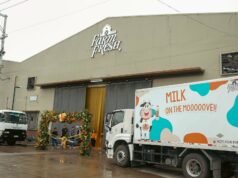By planting more coconuts, the Philippines can help stave off the effects of climate change.
The Philippines has an extensive coconut lands – about 3.2 million hectares. Currently, these lands are planted to least 325 million coconut fruit-bearing trees, which have a high potential to mitigate carbon emissions.
“These coconut lands could be developed for income generating carbon sequestration projects and carbon credit market,” pointed out Dr. Severino S. Magat, extension department manager of the Philippine Coconut Authority (PCA).
Carbon sequestration describes long-term storage of carbon dioxide or other forms of carbon to either mitigate or defer global warming and avoid dangerous climate change.
Carbon dioxide, in the form of gas, can be sequestered out of the atmosphere through photosynthesis. The carbon dioxide is converted into sugar by the plant or emitted back to the air through perspiration.
Carbon stored in plant parts other than the stem wood or trunk are generally decomposable biomass which eventually becomes a part of the soil organic matter (SOM) of which the more stable component is the 50 percent soil organic carbon (SOC).
In his paper presentation entitled, “Productive and Sustainable Coconut Farming Ecosystems as Potential Carbon Sinks in Climate Change Minimization: A Review and Advisory Notes,” Dr. Magat explained the important role of the coconut lands against the negative impacts of climate change.
In coconut, as in most tree crops, carbon is stored or sequestered both by the biomass and the soil of the ecosystem, indicating that the biomass and the soil are the main carbon sinks of atmospheric carbon dioxide.
These “carbon sinks” could be regulated and managed to a great extent by following proper cropping practices, according to Dr. Magat.
A two-year study conducted by PCA showed the annual rate of carbon sequestration in local tall variety coconut crop is 4.78 tons carbon per hectare. That is equivalent to 17.54 tons of carbon dioxide per hectare, Dr. Magat claimed.
But it would be easier if the benefit of the coconut in climate change adaptation is laid out in cash terms through carbon trading.
Assuming that an average of 5.1 tons carbon per hectare of stable biomass and 15 tons carbon per hectare from the sequestered SOC can be attained, the estimated cash benefits would amount to at least P14,170.50 per hectare per year or P 14.17 million per 1,000 hectares coconut land used in the climate-change mitigation.
The cash value could easily double if coconut lands are intercropped with fruit trees and other perennial crops, which are highly capable of carbon sequestration in their plant biomass and the soil.
Under the 1997 Kyoto Protocol, which is an amendment to the United Nations Framework Convention on Climate-Change, industrialized countries have committed to reduce their emissions of carbon dioxide and other green house gases or engage on emissions trading if they maintain or increase emissions of their gases.
In the Clean Development Mechanism of this protocol, industrialized countries can meet part of their target in reducing carbon dioxide emission to the 1990 levels over a five-year period (2008-2012) by purchasing emission reduction credits from developing countries like the Philippines in the form of planted forest, which is achievable in the country due to its vast tracts of open land for the establishments of plantations, Magat said.
The coconut tree meets the criteria of the UN Food and Agriculture as “forest.” The Department of Environment and Natural Resources (DENR) has already included coconut as a reforestation crop through Administrative Order No. 2005-25 effective Nov. 17, 2005.
Coconuts are grown in most of the country. However, 60 percent of the country’s total production comes from the Davao Region, according to Davao regional office of PCA. About 2.7 million coconut trees are planted in the region, with more than half of the total are grown in Davao Oriental.
Currently, the Philippines is one of the largest producers of coconut in the world. “From the more than 14 million metric tons of coconuts that we produce annually, we earn about US$1 billion with the export of coconut oil and copra,” reports Dr. Rafael D. Guerrero III, of the National Academy of Science and Technology.
During the First National Coco Coir Summit held recently in Davao City, Trade and Industry Secretary Gregory L. Domingo said the government has identified the coconut industry as the next priority focus in jobs generation, which can widen its reach to the barangays and involve unskilled labor.
On the first week of March, the First National Coconut Sap Sugar Industry Congress will be held in Davao City again to seize more opportunities in a $1.1 billion alternative sweetener global market.
“We believe our farmers and entrepreneurs can create a niche in natural products whose primary value is their health quality. Coconut sap sugar is one of those products that has already taken off in the market and which still offers so much valuable growth potential,” said Dr. Nicomedes P. Eleazar, BAR director, said in a statement.
Climate change results from the Earth’s atmosphere allowing light to penetrate and reach the planet but preventing heat generated after light hits the ground from radiating back into space.
This condition is attributed to the 30 percent rise in carbon dioxide since pre-industrial times from the use of fossil fuels burnt by motor vehicles, power stations, and other human activities.
Carbon dioxide – released when we burn fossil fuels to produce electricity, use gasoline in our cars, or switch on our natural gas stoves for cooking – has been singled out as the biggest factor in changing the Earth’s climatic conditions.
Noel Grove, author of Air: An Atmosphere of Uncertainty which appeared in National Geographic, explained the role of carbon dioxide in this manner:
“Like panels of glass in a greenhouse, carbon dioxide allows most solar radiation to penetrate the atmosphere but prevents part of the heat radiated by land and bodies of water from escaping into space.
As carbon dioxide accumulates, enough heat may be trapped to gradually warm the atmosphere.”
The consequences of global climate change are so pressing that it doesn’t matter who was responsible for the past; what matters is who is responsible for the future – and that means all of us,” declared actor Arnold Schwarzenegger when he was still the governor of California.
“The rich nations and the poor nations have different responsibilities. But one responsibility we all have, and that is action, action, action, action!”
“The Philippines is extremely vulnerable to the ravages of climate change. Food and fresh water shortages, receding coastlines and an increase in political and economic turmoil are the bleak picture that climate change paints for the country,” the World Wide Fund for Nature said in a statement.




